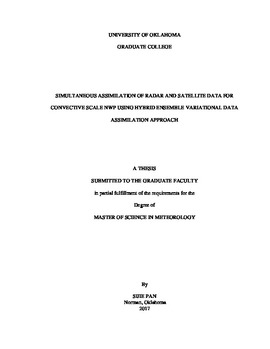| dc.description.abstract | Recently, an ensemble of the three-dimensional variational data assimilation (En3DA) system has been developed based on Advanced Regional Prediction System (ARPS) three-dimensional variational (3DVar) data assimilation (DA) system. However, the DA system is basically designed for radar data assimilation and only compatible with the ARPS model. In this study, the DA system is extended to include the interface that link the DA system with the broadly used Weather Research and Forecasting (WRF) model and to also incorporate additional satellite retrieval data into the DA process. A major goal here is to evaluate whether simultaneous assimilation of satellite retrieval data and radar data through an En3DA approach has positive impacts on initializing and forecasting convective-scale weather.
The first part of this thesis describes the details about the WRF interface and algorithm of assimilating selected satellite data in the En3DA system. To better drive the WRF model, a post-processing program is introduced after DA. The forward operator and its adjoint for satellite data assimilation are embedded into the En3DA system. This DA system and the WRF model are then tested with an idealized tornadic supercell case and a real data tornadic supercell case. More precisely, an idealized supercell storm initialized by the sounding from the tornadic event occurred on 20 May 1977 Del City, Oklahoma, and the real data case is the 26 May 2016 Solomon, Kansas EF-4 tornadic thunderstorm case.
The idealized case evaluates the assimilation of simulated radar and satellite retrieval data under different storm environments. Radar radial velocity, reflectivity, satellite derived cloud water path (CWP) and total precipitable water (TPW) data are produced from the simulated supercell storm, and then assimilated into the WRF model. Two types of experiments are performed. Radar and satellite CWP data are assimilated firstly under a perfect storm environment. Additional TPW data is assimilated under a dry biased environment in the second type of experiments. The first set of experiments indicates that incorporating satellite CWP data into radar data assimilation leads to a much faster initiation of supercell storms. Assimilating CWP data primarily improves the analyses of non-precipitating hydrometeor variables such as cloud and ice, as well as temperature. Results from the second set of experiments demonstrate the importance of the storm environment. With the biased storm environment, assimilation of CWP and radar data can enhance the analyses, but the forecast skill rapidly decreases in 1-hour forecast. Experiments show that the TPW data has a large effectiveness in the first 30-min free forecast, but gives little impact thereafter. The reason is that the TPW is a vertical integration of water vapor content and cannot provide information of the moisture vertical structure which is the key to the storm development.
A similar experimental design is applied to a tornadic supercell storm event on 25-26 May 2016. Four sets of experiments are performed. The first one does not assimilate any data (NoDA), the second one assimilates CWP data alone (CWP), the third one assimilates radar data alone (RAD), and the final one assimilates both radar and satellite data (RADCWP). It is found that best DA and forecast results are provided in RADCWP experiment. In the DA results, the structures of the supercell storm including cold pool, wind fields and reflectivity pattern are reasonably analyzed in the RADCWP. The scope and intensity of strong precipitation area (indicated by reflectivity field) and cold pool area look more reasonable. The positive impacts of both data types are also supported by 1 hour free forecasts after DA cycling. Biases and RMS errors are smallest as well as skill scores are best for the RADCWP experiment when both data are used.
In general, the idealized case with inaccurate moisture environment indicates that the correctness of storm environment is a significant component to the accuracy of the convective scale NWP. The combination of radar data and satellite data within the En3DA method results in better analyses and forecasts than that when only using radar data for the idealized. In the real data case, the positive impact of both radar and CWP data is demonstrated. However, this is only one real data case. Further investigations of the influence of radar and CWP data in storm-scale DA and convective NWP, especially the impact of more satellite data and product such as TPW, will be conducted in the future studies. | en_US |
